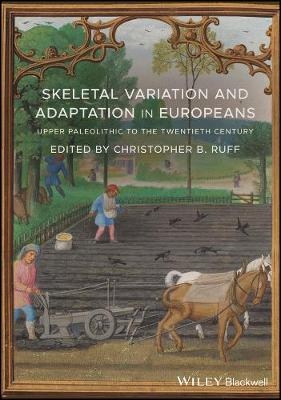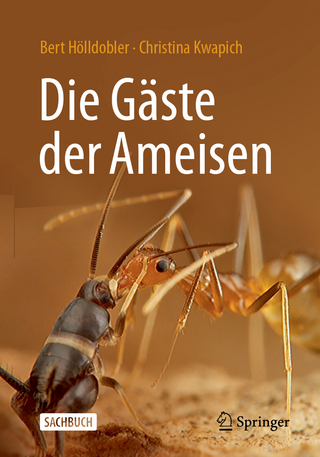
Skeletal Variation and Adaptation in Europeans
Wiley-Blackwell (Verlag)
978-1-118-62796-9 (ISBN)
- Titel z.Zt. nicht lieferbar
- Versandkostenfrei innerhalb Deutschlands
- Auch auf Rechnung
- Verfügbarkeit in der Filiale vor Ort prüfen
- Artikel merken
Skeletal Variation and Adaptation in Europeans: Upper Paleolithic to the Twentieth Century brings together for the first time the results of an unprecedented large-scale investigation of European skeletal remains. The study was conducted over ten years by an international research team, and includes more than 2,000 skeletons spanning most of the European continent over the past 30,000 years, from the Early Upper Paleolithic to the 20th century. This time span includes environmental transitions from foraging to food production, small-scale to large-scale urban settlements, increasing social stratification and mechanization of labor, and climatic changes. Alterations in body form and behavior in response to these transitions are reconstructed through osteometric and biomechanical analyses.
Divided into four sections, the book includes an introduction to the project and comprehensive descriptions of the methods used; general continent-wide syntheses of major trends in body size, shape, and skeletal robusticity; detailed regional analyses; and a summary of results. It also offers a full data set on an external website.
Brings together data from an unprecedented large-scale study of human skeletal and anatomical variations
Includes appendix of specific information from each research site
Synthesizes data from spatial, temporal, regional, and geographical perspectives
Skeletal Variation and Adaptation in Europeans will be a valuable resource for bioarchaeologists, palaeoanthropologists, forensic anthropologists, medical historians, and archaeologists at both the graduate and post-graduate level.
About the Editor Christopher B. Ruff is Director of the Center for Functional Anatomy and Evolution at Johns Hopkins University School of Medicine, Baltimore, MD, USA. Dr. Ruff has published widely in the fields of human osteology, bioarchaeology, and paleontology, and has served as editor of the American Journal of Physical Anthropology and the Yearbook of Physical Anthropology.
List of Contributors xiii
Preface xv
1 Introduction 1
Christopher B. Ruff
1.1 Study Sample 3
1.2 Osteological Measurements 5
1.3 Other Variables 8
1.4 Organization of the Book 9
References 10
2 Body Size and Shape Reconstruction 15
Markku Niskanen and Christopher B. Ruff
2.1 Introduction 15
2.2 Body Size and Shape Estimation 15
2.3 Materials and Methods 17
2.3.1 Estimation of Missing Elements 17
2.3.2 Statistical Procedures 19
2.4 Estimating Body Size and Shape from Skeletal Dimensions 20
2.4.1 Stature 20
2.4.2 Sitting Height and Total Lower Limb Length 22
2.4.3 Limb Segment Lengths 23
2.4.4 Body Breadths 24
2.4.5 Body Mass 25
2.5 Evaluation of Errors in Estimating Body Size and Shape from Skeletal Dimensions 26
2.5.1 Stature Estimation 26
2.5.2 Sitting Height, Lower Limb Subischial Length, and Lower Leg Length 28
2.5.3 Trunk Breadths 30
2.5.4 Body Mass Estimation 30
2.5.5 Sex and Age Effects 32
2.6 Discussion and Conclusions 33
Acknowledgments 34
References 34
3 Quantifying Skeletal Robusticity 39
Christopher B. Ruff
3.1 Cross-Sectional Properties 39
3.2 Cross-Section Reconstruction 40
3.3 Section Moduli 42
3.4 Standardizing for Body Size 44
References 45
4 Temporal and Geographic Variation in Body Size and Shape of Europeans from the Late Pleistocene to Recent Times 49
Markku Niskanen, Christopher B. Ruff, Brigitte Holt, Vladimir Sladek, and Margit Berner
4.1 Environmental Adaptation 49
4.2 European Population History 52
4.3 Materials and Methods 54
4.3.1 Skeletal Samples and Variables 54
4.3.2 Estimating Body Size and Shape from Skeletal Dimensions 55
4.3.3 Anthropometric Samples and Variables 56
4.3.4 Statistical and Graphical Analyses 57
4.4 Results 58
4.4.1 General Temporal Trends in Body Size and Body Proportions 58
4.4.2 Body Size and Shape of Foragers Before and After the Last Glacial Maximum 66
4.4.3 Changes Across the Mesolithic–Neolithic Transition and During the Neolithic 67
4.4.4 The Little Ice Age, the Industrial Revolution, and Very Recent Changes 67
4.4.5 Geographic Differences in Body Size and Proportions 68
4.5 Discussion 76
4.6 Conclusions 81
References 82
5 Temporal and Geographic Variation in Robusticity 91
Brigitte Holt, Erin Whittey, Markku Niskanen, Vladimir Sladek, Margit Berner, and Christopher B. Ruff
5.1 Introduction 91
5.2 Background 91
5.2.1 Limb Bone Robusticity and Subsistence Changes 91
5.2.2 Cultural and Economic Factors 92
5.2.3 Terrain 96
5.3 Materials 96
5.4 Methods 97
5.4.1 Aging and Sexing 97
5.4.2 Reconstruction of Cross]Sectional Dimensions 97
5.4.3 Robusticity Variables 97
5.4.4 Standardizing Cross-Sectional Dimension for Differences in Body Size 98
5.4.5 Quantification of Terrain 98
5.4.6 Categorization of Urbanization 98
5.4.7 Analysis of Robusticity 98
5.5 Results 99
5.5.1 Temporal Trends 99
5.5.1.1 Upper Limb 99
5.5.1.2 Lower Limb 107
5.5.2 Urbanization 116
5.5.4 Terrain 117
5.6 Discussion 118
5.7 Conclusions 126
Acknowledgments 127
References 127
6 Sexual Dimorphism 133
Margit Berner, Vladimir Sladek , Brigitte Holt, Markku Niskanen, and Christopher B. Ruff
6.1 Introduction 133
6.2 Materials and Methods 136
6.3 Results 137
6.3.1 Overall Variation in SD 137
6.3.2 Temporal Trends in Sexual Dimorphism 143
6.3.3 Body Size and Body Proportions 143
6.3.4 Average Strength 144
6.3.5 Cross-Sectional Shape 145
6.3.6 Cross-Sectional Area 146
6.3.7 Comparison of Neolithic Subsistence Groups 146
6.3.8 Urban Versus Rural 148
6.3.9 Femoro-Humeral Strength Ratio (FZp/HZp) 148
6.4 Discussion 149
6.4.1 Body Size and Shape 153
6.4.2 Lower Limb Strength 154
6.4.3 Humerus 155
6.5 Conclusions 157
Acknowledgments 157
References 158
7 Past Human Manipulative Behavior in the European Holocene as Assessed Through Upper Limb Asymmetry 163
Vladimir Sladek, Margit Berner, Brigitte Holt, Markku Niskanen, and Christopher B. Ruff
7.1 Introduction 163
7.2 Materials and Methods 167
7.2.1 Samples 167
7.2.2 Linear Measurements and CSG Parameters 169
7.2.3 Computation of Asymmetry and Sexual Dimorphism 169
7.2.4 Statistical Techniques 171
7.3 Results 171
7.3.1 Asymmetry Variation 171
7.3.1.1 General Differences Between Structural Properties 171
7.3.1.2 Temporal Trends in Asymmetry 173
7.3.1.3 Regional Differences in Asymmetry 190
7.3.2 Right Versus Left Dominance 194
7.3.3 Variation in Right and Left Humeral CSG 196
7.4 Discussion 201
7.5 Summary and Conclusions 203
Acknowledgments 204
References 204
8 Britain 209
Christopher B. Ruff, Evan Garofalo, and Sirpa Niinimaki
8.1 Introduction 209
8.2 Body Size and Shape 213
8.2.1 Body Size 213
8.2.2 Body Shape 218
8.2.3 Comparisons to other Europeans 220
8.3 Cross-Sectional Properties 221
8.3.1 Bone Strength 221
8.3.2 Percentage Cortical Area 225
8.3.3 Comparisons to other Europeans 228
8.3.4 The ‘Amesbury Archer’ 229
8.4 Discussion 233
8.4.1 Body Size and Shape 233
8.4.2 Bone Structure 235
8.5 Conclusions 237
Acknowledgments 237
References 237
9 France and Italy 241
Brigitte Holt, Erin Whittey, and Dannielle Tompkins
9.1 Introduction 241
9.2 Samples 241
9.3 Methods 244
9.3.1 Body Shape 244
9.3.2 Robusticity 244
9.3.3 Statistical Analysis 244
9.4 Results 244
9.4.1 Body Size and Shape 244
9.4.1.1 Temporal Changes Within the FI Group 244
9.4.1.2 Body Size and Shape Sexual Dimorphism 248
9.4.1.3 Impact of urbanization 249
9.4.1.4 Comparisons with Europe 251
9.5 Long Bone Robusticity 252
9.5.1 Temporal Trends 252
9.5.1.1 Upper Limb 252
9.5.1.2 Lower Limb 255
9.5.2 Sexual Dimorphism 260
9.5.3 Bilateral Asymmetry 261
9.5.4 Rural/Urban Status 263
9.5.5 Terrain 263
9.5.6 Comparisons with Europe 263
9.5.6.1 Upper Limb 263
9.5.6.2 Lower Limb 265
9.6 Discussion 270
9.7 Conclusions 276
Acknowledgments 276
References 277
10 Iberia 281
Christopher B. Ruff and Heather Garvin
10.1 Introduction 281
10.2 Body Size and Shape 286
10.2.1 Body Size 286
10.2.2 Body Shape 290
10.2.3 Comparisons to Other Europeans 293
10.3 Cross-Sectional Properties 294
10.3.1 Bone Strength 294
10.3.2 Percentage Cortical Area 300
10.3.3 Comparisons to Other Europeans 304
10.4 Discussion 305
10.4.1 Body Size and Shape 305
10.4.2 Bone Structure 307
10.5 Conclusions 310
Acknowledgments 311
References 311
11 Central European Human Postcranial Variation 315
Vladimir Sladek, Margit Berner, Eliška Makajevova, Petr Veleminsky, Martin Hora, and Christopher B. Ruff
11.1 Introduction 315
11.1.1 Central Europe: Geography and Paleoenvironment 315
11.1.2 Central Europe: Archaeological Context 316
11.2 Materials and Methods 319
11.2.1 Sample 319
11.2.2 Measurements and Variables 321
11.2.3 Statistical Techniques 322
11.3 Results 323
11.3.1 Body Size and Shape Variation 323
11.3.1.1 Stature, Body Mass, and Body Mass Index 323
11.3.1.2 Changes in Body Size Between Central European Holocene and Living Humans 323
11.3.1.3 Relative bi-iliac breadth 326
11.3.1.4 Crural and Brachial Indices 326
11.3.1.5 Sexual Dimorphism in Body Size and Shape 326
11.3.2 Mobility and Sedentism 327
11.3.2.1 Femoral and Tibial Cortical Area and Bending Strength 327
11.3.2.2 Femoral and Tibial Shape Ratio (Zx/Zy) 330
11.3.2.3 Sexual Dimorphism in Lower Limb CSG Properties 330
11.3.3 Manipulative Behavior Changes 330
11.3.3.1 Humeral Cortical Area 330
11.3.3.2 Humeral Bending Strength 331
11.3.3.3 Humeral Directional Asymmetry 332
11.3.3.4 Sexual Dimorphism in Humeral CSG Properties 335
11.3.4 Comparison of Central European Body Size, Shape, and CSG Properties to European Holocene 335
11.4 Discussion 337
11.4.1 Central European UP and Mesolithic 337
11.4.2 Adoption of Agriculture 340
11.4.3 Secondary Products Revolution 341
11.4.4 Origin of Metallurgy 343
11.4.5 The Avars and Nomadic Subsistence in Central Europe 343
11.4.6 The Transition to the Archaic State in the Central Europe 344
11.4.7 Comparison to Living Central Europeans and Impact of Secular Trend 345
11.5 Conclusions 346
Acknowledgments 347
References 347
12 Scandinavia and Finland 355
Markku Niskanen, Heli Maijanen, Juho]Antti Junno, Sirpa Niinimaki, Anna]Kaisa Salmi, Rosa Vilkama, Tiina Vare, Kati Salo, Anna Kjellstrom, and Petra Molnar
12.1 Introduction to Region, Samples, and Techniques 355
12.1.1 Region and its Population History 355
12.1.2 Samples 357
12.1.3 Technique Summary 360
12.2 Body Size and Body Shape 361
12.2.1 Temporal Trends 361
12.2.2 Comparison with pan]European 371
12.2.3 Other Comparisons 374
12.3 Cross-Sectional Properties 377
12.3.1 Temporal Trends 377
12.3.2 Comparisons with pan-European 384
12.3.3 Other Comparisons 385
12.4 Discussion 388
12.4.1 Body Size and Body Shape 388
12.4.2 Cross-Sectional Properties 390
12.5 Conclusions 391
Acknowledgments 391
References 392
13 The Balkans 397
Christopher Ruff and Brigitte Holt
13.1 Introduction 397
13.2 Body Size and Shape 399
13.2.1 Schela Cladovei 399
13.2.2 Mistihalj 402
13.3 Cross-Sectional Properties 402
13.3.1 Schela Cladovei 402
13.3.2 Mistihalj 407
13.4 Discussion 408
13.4.1 Body Size and Shape 408
13.4.2 Bone Structure 411
13.5 Conclusions 414
Acknowledgments 415
References 415
14 Conclusions 419
Christopher B. Ruff, Brigitte Holt, Markku Niskanen, Vladimir Sladek, and Margit Berner
14.1 Body Size and Shape 419
14.2 Long Bone Strength 421
14.3 Other Bone Structural Observations 423
References 424
Appendix 1: Study Samples 427
References 436
Appendix 2.1 443
Notes and Sources 446
References 447
Appendix 2.2 449
Appendix 3.1 451
References 452
Appendix 3.2 455
References 461
Appendix 4 463
Appendix 5 471
Index
| Erscheinungsdatum | 23.10.2016 |
|---|---|
| Verlagsort | Hoboken |
| Sprache | englisch |
| Maße | 185 x 259 mm |
| Gewicht | 1111 g |
| Themenwelt | Medizin / Pharmazie ► Medizinische Fachgebiete |
| Naturwissenschaften ► Biologie ► Humanbiologie | |
| Sozialwissenschaften ► Ethnologie | |
| Sozialwissenschaften ► Soziologie | |
| ISBN-10 | 1-118-62796-2 / 1118627962 |
| ISBN-13 | 978-1-118-62796-9 / 9781118627969 |
| Zustand | Neuware |
| Informationen gemäß Produktsicherheitsverordnung (GPSR) | |
| Haben Sie eine Frage zum Produkt? |
aus dem Bereich


